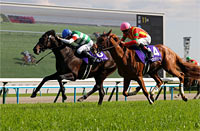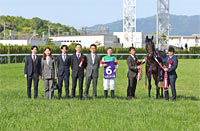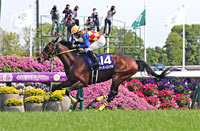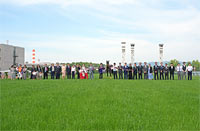2018 News
Tenno Sho (Spring) (G1) - PreviewKyoto Racecourse kicks off the six straight weeks of Grade 1 action in Japan, and on Sunday, April 29, sees one of the country’s great races, the Tenno Sho (Spring), or Emperor’s Cup as it’s called in English, held at the track just to the south of the city of Kyoto. It will be the 79th running of the spring race, but the 157th overall, when including the autumn races of the Tenno Sho, which are run at Tokyo towards the end of the year. Cheval Grand: Last year’s Japan Cup winner finished second in last year’s Tenno Sho (Spring) and third the year before, so is looking to find that bit extra this time around. Jockey Hugh Bowman, who guided him to that superb Japan Cup victory last year, will be back in the saddle aiming for more glory, and also trying to put the horse’s last performance out of mind, where Cheval Grand finished in a career worst 13th in the Grade 1 Osaka Hai, his only start this year. Trainer Yasuo Tomomichi said, “It was his first race of the year last time, and I think the 2,000 meters on the inner course at Hanshin was probably a bit short for him. He didn’t really get into a good rhythm in that race, but came out of it fine. His last two runs in the spring Tenno Sho (Spring) have been good, so I’ll be expecting something similar to those this time.” Clincher: All eyes will be on the 4-year-old colt by Deep Sky, as connections contemplate running him in the Prix de l’Arc de Triomphe later this year, in another bid to break Japan’s jinx in that race. Clincher was second in last year’s Grade 1 Kikuka Sho (Japanese St. Leger), run over 3,000 meters at Kyoto, and has never finished out of the first two at the course. On his most recent start, he finished third to Rainbow Line in the Grade 2 Hanshin Daishoten over 3,000 meters at Hanshin. On April 18, he put in a six furlong time of 83.8 seconds, with three furlongs in 39.5 seconds, and a final furlong time of 12.2 seconds, on the slightly heavy track at the Ritto Training Center. Trainer Hiroshi Miyamoto commented: “He was a bit keen early on in his last race, and when they got to the third corner second time around, he didn’t pick up quite so well and had to settle for third in the end.” Jockey Yutaka Take, winner of the race on no less than eight occasions, was to take the ride, but will now have to miss the race due to a suspension. Kosei Miura, the 28-year-old jockey who broke Take’s rookie season record for most wins in 2008 but has yet to win a Grade 1 race, is expected to take the ride. Rainbow Line: The 5-year-old is coming off a good win in the Grade 2 Hanshin Daishoten last time, and this will be his tenth race at Grade 1 level – his best finish in a Grade 1 was when he ran second in the 2016 Kikuka Sho (Japanese St. Leger). He finished 12th in last year’s Tenno Sho (Spring), when the pace was a bit too hot to handle. Assistant trainer Keiichi Asami said, “He won cleverly last time and adjusted well to the pace and the way the race was run. It was a similar effort to last year’s Tenno Sho (Autumn), and this is the way he needs to run to show his best. He’ll have opponents he’s met before this time too, so I’m looking forward to what he can do.” Ganko: The 5-year-old by Nakayama Festa has been producing some good results since being campaigned back into races on turf. Twenty of his 28 career races have been on dirt, but one of his three wins on turf came most recently when he won the Grade 2 Nikkei Sho over 2,500 meters at Nakayama in pretty good style. Trainer Shigeki Matsumoto said, “The jockey did well last time, and I think it was a good win. After that, the horse spent some time in the pool to take away his tiredness, and now he’s back in work. It’ll be his first time at 3,200 meters, and while in his best races he hasn’t shown anything other than running from a forward position, I believe he can adapt to any kind of race.” Albert: The evergreen Albert is now a 7-year-old, earning nearly 350 million yen in his career. He finished 5th in last year’s Tenno Sho (Spring), and sixth the year before, so it’s a race he can be competitive in. In his only race this year, he finished fourth to Rainbow Line in the Hanshin Daishoten. Assistant trainer Kazutomo Mori commented: “It was his first race last time after a layoff, and so as usual he looked a bit heavy and needed the race, but having said that he did run on well at the end. He’s come back well from that and is the type to improve with a race behind him.” Satono Chronicle: The 4-year-old by Heart’s Cry is bidding to give his trainer, Yasutoshi Ikee, his first win in the race (his father won it three times as a trainer), and the colt is three wins and four seconds from his 11 career starts, showing how consistent he is. He is coming off a second place finish to Rainbow Line in the Hanshin Daishoten. Assistant trainer Hiroshi Kanetake said, “He was back from a break last time, but he was in good condition and it was a good run over 3,000 meters. He’s also run in the Kikuka Sho over that trip, so I think the further he goes, he’s still going to put in a good effort over these longer distances.” Chestnut Coat: Another 4-year-old colt by Heart’s Cry, Chestnut Coat has started the year in good form, winning twice and finishing second in his three races so far this year. What’s more the rise in class to Grade 2 level last start didn’t seem to bother him at all, finishing second to Ganko in the Nikkei Sho. Assistant staff at trainer Yoshito Yahagi’s stable commented: “He finished off well last time to grab second, and we thought that was a big run from him at the Nakayama track. He seems to be a talented horse who’s shown a lot of improvement since last autumn.”
|
|


























